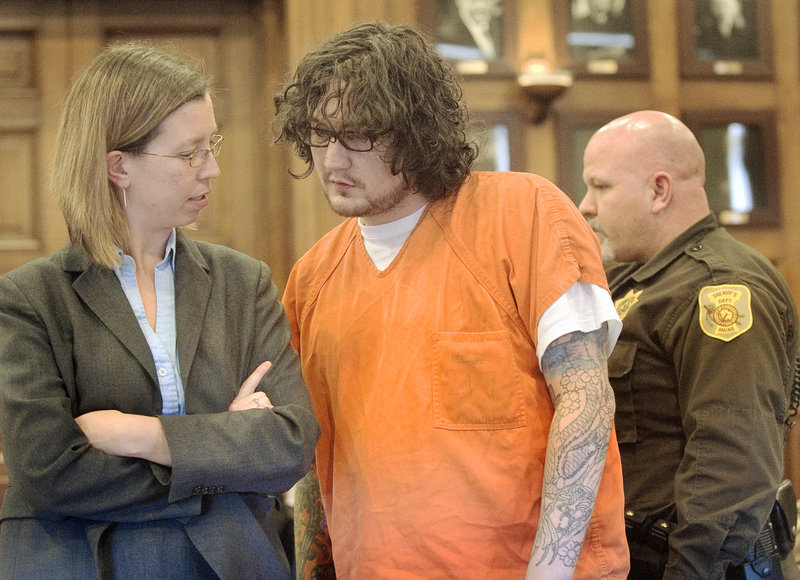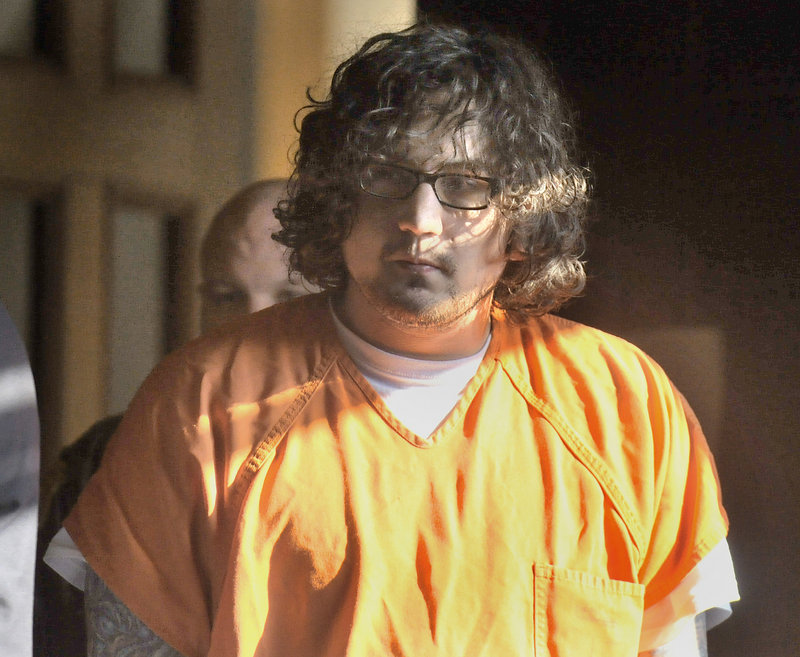PORTLAND — Over the course of Chad Gurney’s two-week murder trial, lawyers for the state and the defense used every tool available in the justice system to get inside the defendant’s mind.
Interviews with police. Journal entries. E-mails. Reports from friends, past girlfriends and family members. Medical records. Evaluations by psychologists and psychiatrists.
All to answer two central questions: Did Gurney understand the wrongfulness of his actions when he killed 18-year-old Zoe Sarnacki in his apartment in Portland, and does he belong in prison or in the state psychiatric hospital?
It is up to Justice Roland Cole to deliver answers.
After listening to closing arguments Thursday, the judge said he needs time to read through some of the documents introduced over several days of testimony in Cumberland County Superior Court. Cole told the parties that he hopes to call them back for a verdict next week.
Gurney, 29, killed Sarnacki on May 25, 2009. He turned himself in to police about 12 hours later and admitted that he had strangled Sarnacki, mutilated her body and set it on fire.
He later pleaded not criminally responsible by reason of mental disease or defect, commonly known as an insanity plea, and waived his right to have his case heard by a jury.
His lawyers’ core argument was that Gurney was psychotic and severely delusional at the time, and believed that signs in his surroundings commanded him to kill Sarnacki as part of a test given to him by a spiritual guide he had met a few months earlier in Hawaii.
During closing arguments, attorney Sarah Churchill said Gurney’s thought processes were so distorted that he lacked the mental capacity to understand the consequences of his actions.
“This case has always been about why. Why did Chad Gurney end the life of Zoe Sarnacki?” Churchill said. “Ms. Sarnacki died because Chad Gurney was suffering from a mental disease or defect on May 25, 2009.”
Churchill said Gurney’s delusional thinking was evident in his interactions with friends, journal entries, e-mails, text messages, and his behavior before and after the killing.
“The ‘why’ only has one reasonable answer in this case,” she said. It was because of Gurney’s “concrete belief that Zoe was a test, she was a reflection of himself, she was godlike, and he was sending her off to eternal life.”
Churchill asked Cole to rely on the report and testimony of the expert defense witness, Dr. Harold Bursztajn, a psychiatrist from Harvard Medical School.
Bursztajn said Gurney’s psychosis was brought on by the lingering effects of a brain injury, exacerbated by Gurney’s decision to wean himself off narcotic painkillers in the months before Sarnacki’s death.
Gurney was unable to comprehend what he had done to Sarnacki until hours later, after he checked into a motel in Old Orchard Beach, Churchill argued. She said that’s when he felt horror and remorse.
Churchill said the three doctors who evaluated Gurney for the State Forensic Service did not thoroughly review his medical records and did not properly factor in the effect of his brain injury, suffered in a nearly fatal van crash in 2005.
“Dr. Bursztajn’s opinion is the most reliable because it’s the most comprehensive,” she said.
The lead prosecutor, Assistant Attorney General Lisa Marchese, told Cole that Bursztajn’s opinion is fundamentally flawed and unreliable.
Marchese said Bursztajn picked and chose the data that supported his theory and ignored evidence suggesting alternatives. As she did during cross-examination, Marchese pointed out that Bursztajn was paid $500 an hour and close to $100,000 in all for his work on the case.
“Dr. Bursztajn was paid an obscene amount of money to come into this case and come to a conclusion,” she said. He “came to Maine and did exactly what he was paid to do.”
Marchese asked Cole to disregard Bursztajn’s testimony and focus instead on the opinions of the psychiatrist and two psychologists who evaluated Gurney on a contract basis for the State Forensic Service.
Drs. Dan Filene, Peter Donnelly and Andrew Wisch all testified that Gurney had mental health problems, ranging from depression to post-traumatic stress disorder to schizotypal personality disorder.
Gurney often took things as “signs” directing him on the choices to make in life, the doctors agreed.
But Filene, Donnelly and Wisch — independently of one another — concluded that Gurney had the mental capacity to understand that he was killing Sarnacki and knew it was wrong, Marchese said.
“Judge, this case isn’t even close,” she said.
“The affirmative defense of (not criminally responsible) is reserved for those truly psychotic, truly mentally ill people who don’t appreciate that what they are doing is wrong,” Marchese said. “Chad Gurney just isn’t one of those people.”
A more likely explanation for the killing, Marchese said, is that Gurney was angry at Sarnacki. She had slept with another man, and had turned Gurney down a few days before the killing when he asked her to quit her job and travel with him.
Gurney told a friend in a cell phone conversation about 12 hours after the killing that Sarnacki had hurt him, he was tired of being hurt, and he snapped. Marchese said that was the most reliable of Gurney’s multiple explanations of what happened.
If he is found guilty, Gurney will face a minimum of 25 years and a maximum of life in prison.
If Cole finds him not criminally responsible, Gurney will be committed to the Riverview Psychiatric Center in Augusta until he can prove to the court that he is no longer a threat to society.
Gurney was a standout lacrosse goalie at Oak Hill High School in Wales and went on to play for Liberty University in Virginia.
In 2005, he and his teammates were on their way to a match when one of their vans was knocked into the path of a tractor-trailer. Emergency crews used the Jaws of Life extrication device to free the seriously injured Gurney from the wreckage.
Doctors transplanted a bone from a hip into one of his legs and operated on his back and an arm. Gurney also suffered a brain injury.
He returned to Maine and eventually received a seven-figure settlement from Liberty University. He endured 27 surgeries from the time of the crash until early 2009.
At the time of the killing, Gurney was living on $7,000 a month from the settlement and about $900 a month from a Social Security disability claim. He collected guns and swords, and covered most of his body with elaborate tattoos.
Sarnacki, who had attended Deering High School, met Gurney at a tattoo shop in Portland’s Old Port. She had been waiting until her 18th birthday, in March 2009, to get a tattoo of a Gustav Klimt painting on her forearm.
Sarnacki’s family believes she was likely drawn to the older man because of his interest in Buddhism and travel. Gurney had bought a ticket to fly to Thailand on May 27, 2009.
On the afternoon of May 25, Gurney strangled Sarnacki in the loft of his apartment on Cumberland Avenue. He had sex with her corpse and decapitated her with multiple knives. He then drove to a nearby gas station, filled a jug with $2.50 worth of gasoline, returned to the apartment and set the body on fire.
Gurney drove to Old Orchard Beach, checked into a motel, spent time in the hot tub and went out to dinner by himself.
Shortly after 2 a.m. on May 26, he spoke to his best friend, Corey Bryant, on a cell phone. Portland police officer Jason King stopped Bryant for running a red light, and Bryant put King on the phone with Gurney. That ultimately led Gurney to turn himself in later that morning.
Staff Writer Trevor Maxwell can be contacted at 791-6451 or at:
tmaxwell@pressherald.com
Send questions/comments to the editors.





Success. Please wait for the page to reload. If the page does not reload within 5 seconds, please refresh the page.
Enter your email and password to access comments.
Hi, to comment on stories you must . This profile is in addition to your subscription and website login.
Already have a commenting profile? .
Invalid username/password.
Please check your email to confirm and complete your registration.
Only subscribers are eligible to post comments. Please subscribe or login first for digital access. Here’s why.
Use the form below to reset your password. When you've submitted your account email, we will send an email with a reset code.